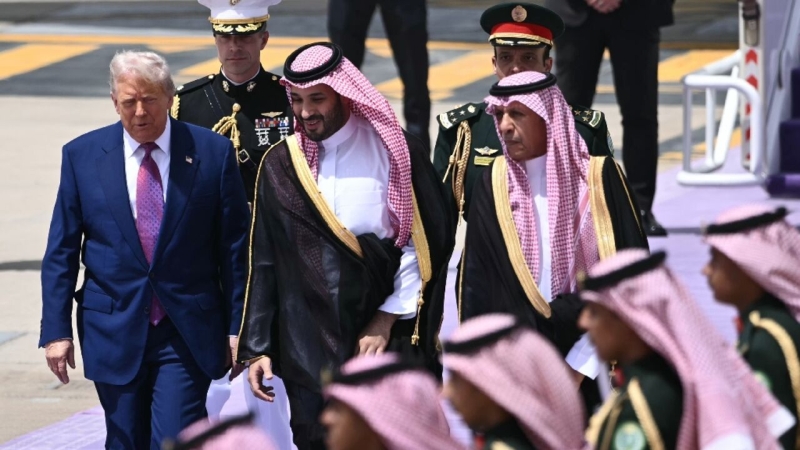- US Issues Travel Alert for Bangladesh Ahead of Election |
- Air ambulance carrying bullet-hit Hadi flies for Singapore |
- Can Dhaka’s arms recovery drive ensure peaceful polls? |
- ‘Unhealthy’ air quality recorded in Dhaka Monday morning |
- BD peacekeepers' deaths: UN chief calls Dr. Yunus, offers condolence |
Trump in Saudi Arabia on Gulf Tour, Eyeing Major Deals

US President Donald Trump received a grand reception in Saudi Arabia on Tuesday as he launched the first state visit of his second presidential term. While his itinerary suggests ambitious business engagements, progress on key Middle Eastern challenges may prove far more elusive.
As Air Force One touched down in Riyadh, Saudi fighter jets performed a ceremonial escort. Trump was greeted on the tarmac by Crown Prince Mohammed bin Salman, with the two leaders reviewing a military honour guard in a display of warm ties between the nations.
Trump is scheduled to address an investment forum in Riyadh, where prominent American business leaders—including personal associates—are expected to attend. His choice to prioritise Gulf monarchies over traditional Western allies for his first overseas trip reflects both the region’s growing geopolitical influence and his longstanding business interests.
This visit echoes Trump’s first foreign trip as president in 2017, when he famously joined a sword dance and posed with a glowing orb in the Saudi capital.
Trump’s rapport with Gulf leaders stands in sharp contrast to the cooler approach of his predecessor, who once pledged to isolate the crown prince over the 2018 killing of journalist Jamal Khashoggi. In the years since, Saudi Arabia has invested heavily in reshaping its global image, from expanding women's rights to spearheading initiatives in technology and artificial intelligence. It has also emerged as a diplomatic actor, hosting quiet talks between global powers on sensitive conflicts.
Neighbouring Qatar and the United Arab Emirates have also carved out prominent international roles. Qatar has acted as a key intermediary in efforts to mediate conflicts involving Israel and Hamas, while the UAE has bolstered its influence through regional diplomacy and strategic investments.
The central focus of Trump’s Gulf tour is expected to be business, not diplomacy. Gulf leaders have signalled strong interest in securing trade and defence deals, including a possible $600 billion investment pledge from Saudi Arabia into US ventures.
Trump, characteristically upbeat, quipped that he would ask the crown prince to raise the figure to $1 trillion, saying, “I think they'll do that because we’ve been very good to them.”
According to a source close to the Saudi defence establishment, the kingdom is seeking to acquire cutting-edge US military technology, including F-35 fighter jets and advanced air defence systems, with delivery conditioned on the current administration’s term.
While economic cooperation is front and centre, several regional issues remain unresolved. Chief among them is the question of normalising relations between Saudi Arabia and Israel—a goal both Trump and his predecessor have pursued. However, Riyadh maintains that recognition of Israel hinges on the establishment of a Palestinian state.
Meanwhile, Israel’s ongoing military campaign in Gaza and the humanitarian crisis it has triggered continue to strain the region’s stability. The United States has recently engaged in direct talks with Hamas to secure the release of American hostages, including one just days before Trump’s visit.
Iran is also likely to factor into Trump’s discussions. Fresh US sanctions were imposed on Tehran's nuclear programme following indirect talks in Oman, signalling persistent tensions despite cautious optimism from both sides.
Controversy also surrounds Trump’s reported plans to accept a luxury Boeing jet from the Qatari royal family for future use as Air Force One. Defending the move, he described it as "a very public and transparent transaction," adding, “I would never be one to turn down that kind of an offer.”

